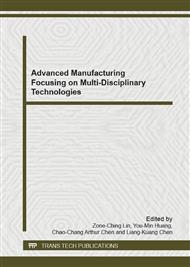[1]
A. Atkins, Fracture in forming, J. Mater. Proc. Tech. 56 (1996) 609-618.
Google Scholar
[2]
M. A. Shabara, A. A., El-Domiaty, M. A. Kandil, Validity assessment of ductile fracture criteria in cold forming, J. Mater. Eng. Perf. 5 (1996) 478-488.
DOI: 10.1007/bf02648845
Google Scholar
[3]
H. Li, M.W. Fu, J. Lu, H. Yang, Ductile fracture: experiments and computations, Int. J. Plast. 27 (2011) 147-180.
Google Scholar
[4]
M. D. Cockroft, D. J. Latham, Ductility and the workability of metals, J. Inst. Metals, 96 (1968) 33-39.
Google Scholar
[5]
S. I. Oh, C. C. Chen, S. Kobayashi, Ductile fracture in axisymmetric extrusion and drawing. Part 2: Workability in extrusion and drawing, J. Eng. Ind. -Trans. ASME. 101 (1979) 36-44.
DOI: 10.1115/1.3439471
Google Scholar
[6]
D. -C. Ko, B. -M. Kim, J. -C. Choi, Prediction of surface-fracture initiation in the axisymmetric simple upsetting of an aluminum alloy, J. Mater. Proc. Tech. 62 (1996) 166-174.
DOI: 10.1016/0924-0136(95)02200-7
Google Scholar
[7]
R. Hambli, M. Reszka, Fracture criteria identification using inverse technique method and blanking experiment, Int. J. Mech. Sci. 44 (2002) 1349-1361.
DOI: 10.1016/s0020-7403(02)00049-8
Google Scholar
[8]
N. Ogawa, M. Shiomi, K. Osakada, Forming of magnesium alloy at elevated temperatures for precision forming, Int. J. Mach. Tools Manuf. 42 (2002) 607-614.
DOI: 10.1016/s0890-6955(01)00149-3
Google Scholar
[9]
W. T. Zheng, S. H. Zhang, D. Sorgente, L. Tricarico, G. Palumbo, Approach of using a ductile fracture criterion in deep drawing of magnesium alloy cylindrical cups under non-isothermal condition, Proc. Inst. Mech. Eng., Part B: J. Eng. Manuf. 221 (2007).
DOI: 10.1243/09544054jem756
Google Scholar
[10]
S. Alexandrov, D. Vilotic, A theoretical experimental method for the identification of the modified Cockroft - Latham ductile fracture criterion, Proc. IMechE, Part C: J. Mech. Eng. Sci. 222 (2008) 1869-1872.
DOI: 10.1243/09544062jmes1055
Google Scholar
[11]
R. B. Figueiredo, P. R. Cetlin, T.G. Langdon, The evolution of damage in perfect-plastic and strain hardening materials processed by equal-channel angular pressing, Mater. Sci. Eng.: A. 518 (2009) 124-131.
DOI: 10.1016/j.msea.2009.04.007
Google Scholar
[12]
A. Pesin, V. Salganik and D. Pustovoytov, Modeling of surface crack form change of continuously cast slabs in roughing rolling at wide strip mill2000, Steel Res. Int. 81 (2010) 82-85.
DOI: 10.1063/1.3457534
Google Scholar
[13]
S. Alexandrov , O. Richmond, Singular plastic flow fields near surfaces of maximum friction stress, Int. J. Non-Linear Mech. 36 (2001) 1-11.
DOI: 10.1016/s0020-7462(99)00075-x
Google Scholar
[14]
S. Alexandrov, E. Lyamina, Prediction of fracture in the vicinity of friction surfaces in metal forming processes, J. Appl. Mech. Tech. Physics. 47 (2006) 757-761.
DOI: 10.1007/s10808-006-0112-2
Google Scholar
[15]
S. Alexandrov, E. Lyamina, Non-local criteria of fracture near of friction surfaces and its application to extrusion and drawing processes, J. Mach. Manuf. Rel. 36 (2007) 262-268.
DOI: 10.3103/s1052618807030090
Google Scholar
[16]
S. Alexandrov, E. Lyamina, Singular solutions for plane plastic flow of pressure-dependent materials, Doklady Physics. 47 (2002) 308-311.
DOI: 10.1134/1.1477887
Google Scholar
[17]
S. Alexandrov, D. Harris, Comparison of solution behaviour for three models of pressure-dependent plasticity: A simple analytical example, Int. J. Mech. Sci. 48 (2006) 750-762.
DOI: 10.1016/j.ijmecsci.2006.01.009
Google Scholar
[18]
S. Alexandrov, G. Mishuris, Qualitative behaviour of viscoplastic solutions in the vicinity of maximum-friction surfaces, J. Eng. Math. 65 (2009) 143-156.
DOI: 10.1007/s10665-009-9277-z
Google Scholar
[19]
S. Alexandrov, Specific features of solving the problem of compression of an orthotropic plastic material between rotating plates, J. Appl. Mech. Tech. Physics. 50 (2009) 886-890.
DOI: 10.1007/s10808-009-0120-0
Google Scholar
[20]
M. F. Kanninen, C. H. Popelar, Advanced Fracture Mechanics, University Press, (1985).
Google Scholar
[21]
D. M. Norris, J. E. Reaugh, B. Moran, D. F. Quinones, A plastic-strain, mean-stress criterion for ductile fracture, J. Eng. Mater. Tech. – Trans. ASME. 100 (1978) 279-286.
DOI: 10.1115/1.3443491
Google Scholar
[22]
T. Aukrust, S. LaZghab, Thin shear boundary layers in flow of aluminium, Int. J. Plast. 16 (2000) 59-71.
DOI: 10.1016/s0749-6419(99)00047-9
Google Scholar
[23]
S. P. Moylan, S. Kompella, S. Chandrasekar, T. N. Farris, A new approach for studying mechanical properties of thin surface layers affected by manufacturing processes, J. Manuf. Sci. Eng. – Trans. ASME. 125 (2003) 310-315.
DOI: 10.1115/1.1559161
Google Scholar
[24]
T.A. Trunina, E.A. Kokovkhin, Formation of a finely dispersed structure in steel surface layers under combined processing using hydraulic pressing, J. Mach. Manuf. Rel. 37 (2008) 160-162.
DOI: 10.3103/s1052618808020118
Google Scholar
[25]
S. E. Aleksandrov, D. Z. Grabko, O. A. Shikimaka, The determination of the thickness of a layer of intensive deformations in the vicinity of the friction surface in metal forming processes, J. Mach. Manuf. Rel. 38 (2009) 277-282.
DOI: 10.3103/s105261880903011x
Google Scholar
[26]
S. Alexandrov, The strain rate intensity factor and its applications: a review, Mater. Sci. Forum. 623 (2009) 1-20.
Google Scholar
[27]
S. Alexandrov, Y. -R. Jeng, Influence of pressure - dependence of the yield criterion on the strain-rate-intensity factor, J. Eng. Math. 71 (2011) 339-348.
DOI: 10.1007/s10665-011-9458-4
Google Scholar
[28]
R. Hill, The Mathematical Theory of Plasticity, Clarendon Press, (1950).
Google Scholar
[29]
B. Avitzur, "Analysis of central bursting defects in drawing and extrusion, J. Eng. Ind. – Trans. ASME. 90 (1968) 79-91.
DOI: 10.1115/1.3604610
Google Scholar


